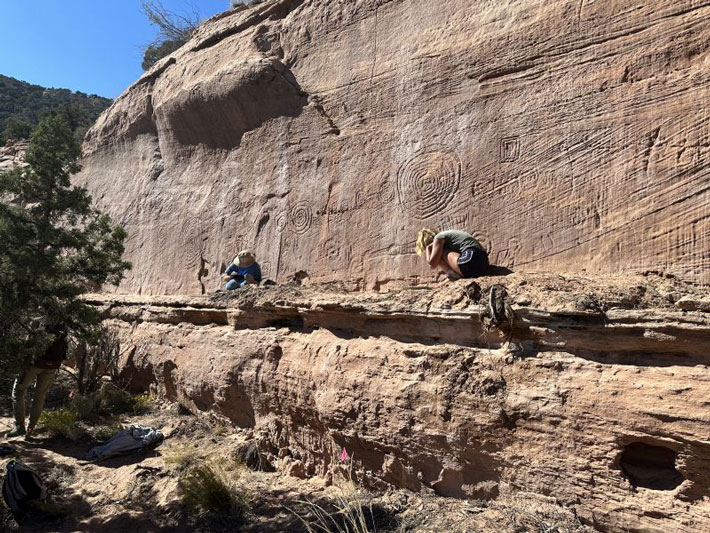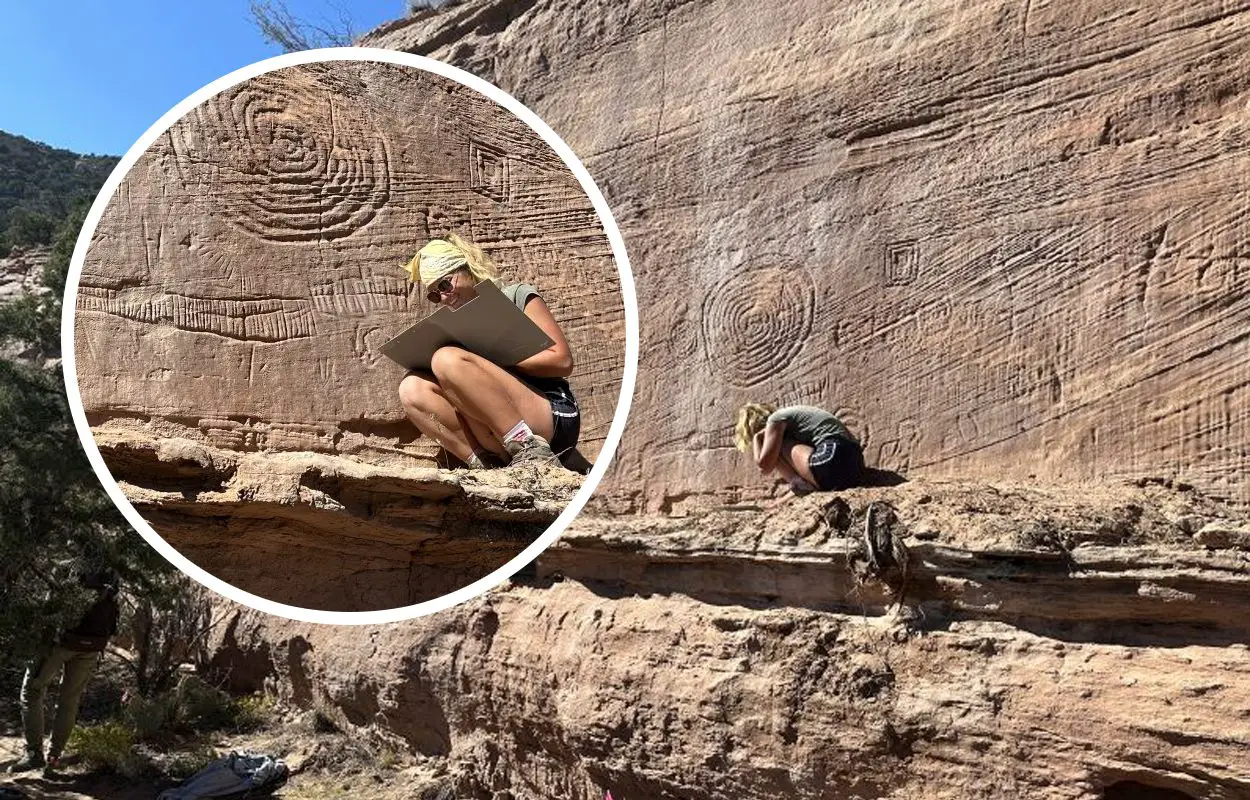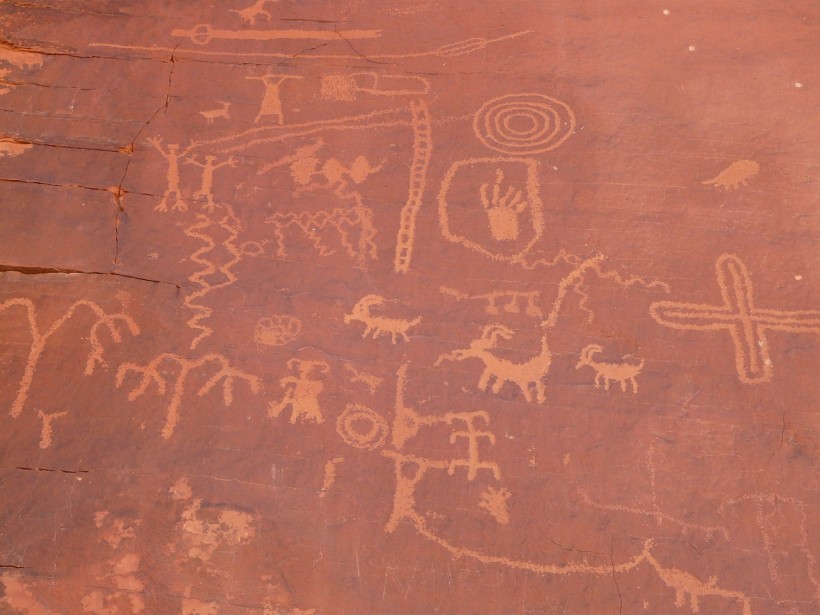Anthropology
Related: About this forumDiscovery of 'calendar' rock carvings from Ancestral Pueblo in US Southwest surpasses 'wildest expectations'
By Jennifer Nalewicki published December 20, 2023
Spiral petroglyphs carved into a canyon wall on the Colorado-Utah border may have been used as a calendar by the Ancestral Pueblo.

Among the artworks, archaeologists discovered a series of spirals that may have been used as a calendar. (Image credit: Jagiellonian University)
While investigating a site in the US Southwest, archaeologists discovered a series of ancient rock carvings that early Native Americans may have used as a calendar.
The site, known as the Castle Rock Pueblo, is on the Mesa Verde plateau straddling the Colorado-Utah border and is best known for the Ancestral Pueblo settlements that are carved into the surrounding canyon walls, according to a statement.
The Ancestral Pueblo were a group of Indigenous peoples who inhabited the Castle Rock Pueblo from about the 1250s to 1274, according to a 2020 study in the journal Antiquity.
"The agricultural Pueblo communities developed one of the most advanced Pre-Columbian cultures in North America," Radosław Palonka, an archaeology professor at Jagiellonian University in Poland who led the investigation, said in the statement. "They perfected the craft of building multi-story stone houses, resembling medieval town houses or even later blocks of flats. The Pueblo people were also famous for their rock art, intricately ornamented jewelry and ceramics bearing different motifs painted with a black pigment on white background."
During their investigation, the archaeologists discovered a series of petroglyphs (rock carvings) chiseled into the canyon walls high above the cliff settlements. The carvings, which include spirals stretching more than 3 feet (1 meter) in diameter, continue across more than 2.5 miles (4 kilometers), according to the statement.
More:
https://www.livescience.com/archaeology/discovery-of-calendar-rock-carvings-from-ancestral-pueblo-in-us-southwest-surpasses-wildest-expectations
~ ~ ~
Ancestral Puebloan Rock Art Recorded
Tuesday, December 19, 2023

Ancestral Puebloan Rock Art Recorded
Social Bookmark Button Share
Tuesday, December 19, 2023
Ancestral Puebloan Rock Art(Jagiellonian University)KRAKOW, POLAND—Rock art carved by Ancestral Puebloans has been recorded in the area of Castle Rock Pueblo on the border between Colorado and Utah, according to a Newsweek report. The Castle Rock village site, located on the Mesa Verde plateau, was inhabited in the thirteenth century A.D. “I used to think that we studied this area thoroughly, conducting full-scale excavations, geophysical surveying, and digitalization,” said Radosław Palonka of Jagiellonian University. “Yet, I had some hints from older members of the local community that something more can be found in the higher, less accessible parts of the canyons.” Some of these rock panels measure more than two-and-a-half miles long, he explained, adding that the newly identified images include spiral shapes measuring about three feet in diameter. Palonka and his colleagues think the spirals may have been used for astronomical observations and to keep track of special days in the calendar, such as the spring and autumn equinoxes. To read about a specific turkey breed raised by the Ancestral Puebloans in the American Southwest, go to "In Full Plume."
https://www.archaeology.org/news/12008-231219-ancestral-puebloan-art
~ ~ ~

Image Credit : Jagiellonian University in Kraków
By:
Mark Milligan
Date:
December 13, 2023
Archaeologists have discovered Pueblo astronomical carvings and paintings in Colorado
Archaeologists from the Jagiellonian University in Kraków have announced the discovery of astronomical carvings and paintings associated with the Pueblo culture.
The discovery was made at the Castle Rock Pueblo settlement complex, located on the Mesa Verde plateau on the border between Colorado and Utah, United States.
Previous research of the area has identified Pueblo petroglyphs from the 12th and 13th century AD, and 15th-17th century AD rock panels featuring hunting scenes associated with the Ute tribe.
The Puebloans, also known as the Pueblos, were an early Native American civilisation that emerged around AD 100 in regions spanning Utah, along with sections of Arizona, New Mexico, and Colorado.
The culture was one of the most advanced Pre-Columbian societies, constructing multistorey stone houses, rock art, intricately ornamented jewellery, and ceramics decorated with painted motifs.
Based on reports from members of the local community, archaeologists begun exploring the hard-to-reach areas of the Sand Canyon, Graveyard Canyon and Rock Creek Canyon at the Castle Rock Pueblo settlement complex. At a height of 800 metres above the cliff settlements, the team found the petroglyphs on rock panels that stretch over 4 kilometres around the large plateau.
Carved on the rock panels are spirals up to one metre in diameter, which were used by the Pueblo people for astronomical observations and to determine the summer and winter solstices, as well as the spring and autumn equinoxes.
Also discovered are painted depictions showing images of warriors and shamans, which according to the researchers date from the 3rd century AD during the Basketmaker Era.
Prof. Radosław Palonka from the Jagiellonian University in Kraków, said: “These discoveries forced us to adjust our knowledge about this area. Definitely we have underestimated the number of inhabitants who lived here in the 13th century and the complexity of their religious practices, which must have also taken place next to these outdoor panels.”
Header Image Credit : Jagiellonian University in Kraków
https://www.heritagedaily.com/2023/12/archaeologists-have-discovered-pueblo-astronomical-carvings-and-paintings-in-colorado/149934
https://www.researchgate.net/profile/Radoslaw-Palonka/publication/320547029/figure/fig2/AS:551834169208832@1508578926731/Site-5MT135-Sunny-Alcove-cliff-dwelling-located-on-west-side-of-Sand-Canyon-documented.png
https://www.researchgate.net/profile/Radoslaw-Palonka/publication/334810951/figure/fig1/AS:876139920760832@1585899443380/Rock-art-paintings-in-the-central-part-of-the-Site-5MT264-The-Gallery-and-murals-on_Q320.jpg


niyad
(129,527 posts)What an incredible find! Thank you so much for sharing this.
Warpy
(114,383 posts)at least since the last glacial maximum and probably long before then, it should come as no surprise that they were sophisticated when it came to marking out the seasons, their lives depended on knowing what was growing and where and when it was growing. The agricultural revolution at the end of the last ice age happened here, too, the Pueblos have a longstanding farming tradition.
The Americas presented early people with a challenge they hadn't faced in Eurasia, where the land lies east to west with large areas of land with similar climate. Here it runs north-south with vastly different climates over relatively small terrain and micro weather that was more violent and less predictable than it was in Eurasia.
Our calendar is still less precise than that of the Maya, after all.
I'm still getting blown away by just how ancient this part of the country is in terms of human habitation.